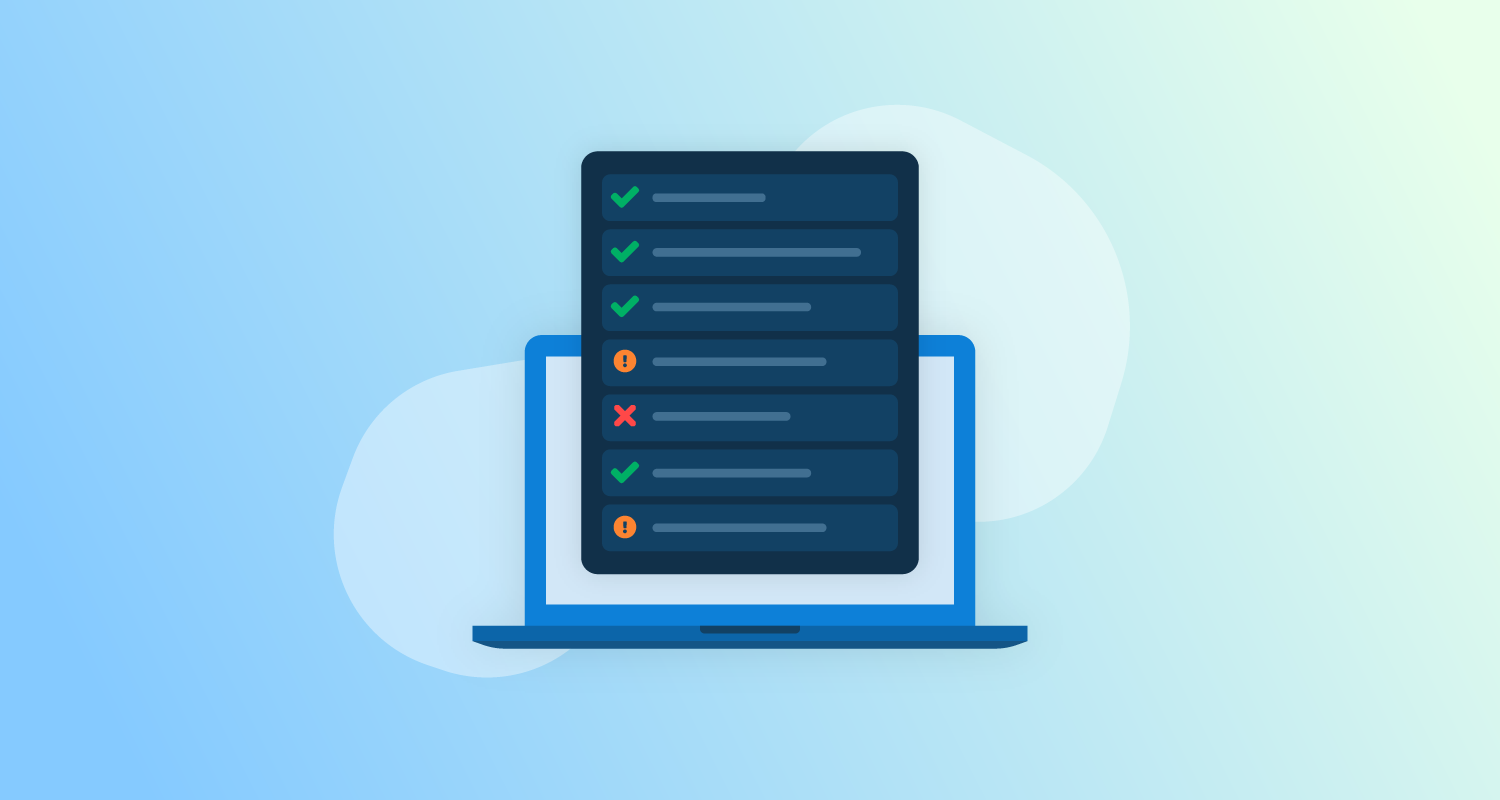What is a Continuous Delivery pipeline?
A Continuous Delivery (CD) pipeline is an automated sequence of stages that takes software from code commit to production. The pipeline includes all the steps required to deliver the new software version, including deployments and acceptance tests. CD encourages a high level of automation and helps ensure software is always deployable.
CD pipelines build and test a developer’s changes to tell them within 5 minutes if they’ve introduced a fault. Longer running tests happen after the initial commit tests and cover end-to-end scenarios and non-functional fitness tests. As a software version progresses through the pipeline, confidence increases in its suitability for production.
Continuous Delivery pipelines provide a fast and reliable route to production, increasing the ease and frequency of deployments while reducing the rate of errors experienced by end users.
5 key elements of a Continuous Delivery pipeline
1. Version control systems
Version control systems (VCS) are foundational to software delivery. They let teams manage changes to source code and provide a history of all changes, allowing developers to identify and revert bad changes. Popular VCS tools, like Git, let developers branch and merge the code. This means developers can work on changes simultaneously, though minimizing the number and age of branches is crucial to Continuous Delivery.
VCS provide a single source of truth for the code, usually represented by a main branch. This single-source approach enhances consistency and prevents costly errors that arise from using outdated code versions. By integrating VCS with other pipeline components, teams can automate the update and deployment processes, synchronizing changes across environments.
2. Automated Builds
Automated builds convert source code into a deployable software package. In a CD pipeline, this happens once for each software version, and the resulting package is reused throughout the pipeline. The build stage also provides developers with fast feedback from a set of automated tests. Only software versions that pass the build and initial tests progress to the next pipeline stage.
Automated builds increase developer confidence, as developers can integrate their changes into the main branch and know they will receive feedback within 5 minutes. Identifying and resolving issues is easier when the changes are still fresh in the developer’s mind.
3. Continuous Integration
Continuous Integration (CI) involves developers frequently merging their changes into a shared repository. Keeping development loops short reduces the frequency and size of integration tasks, such as resolving merge conflicts. When you integrate code into the main branch every few hours, merges are usually automatic. CI tools like Jenkins and CircleCI will run a build and automated tests for each merge to detect issues early and flag them for quick resolution.
The CI process depends on crucial human factors, such as frequently making small changes and prioritizing issues raised by the pipeline over new features. Automated builds and tests don’t prevent ‘integration hell’, which is caused by long-lived branches. CI helps teams reduce the overhead of failure demand and creates a sustainably faster development cycle.
Related content: Read our guide to Continuous Delivery vs Continuous Integration
4. Automated testing
Automated testing is integral to a Continuous Delivery pipeline. It ensures that new code doesn’t break existing application behavior. Most programming languages offer frameworks that support unit tests, integration tests, and acceptance tests, which provide fast feedback on the software’s fitness for purpose. There are also specialized options to test performance, security, and code quality.
In Continuous Delivery, the tests are run in stages to give developers fast feedback and to provide the potential to run different automated suites in parallel. Automated tests increase developer and stakeholder confidence in the suitability of each software version. They also move the constraint for software delivery away from the test process, which, in the case of manual testing, often sets the pace of throughput.
5. Deployment Automation
Deployment automation streamlines the process of moving code changes through testing and production environments. It eliminates repetitive manual deployment tasks, bringing consistency and reliability to software delivery. Automated deployment tools help you model environments, manage configuration, and progress your software version to production in a scalable and reliable way.
Automating deployment across all environments means the process is tested as often as the software. It also makes it easy to see which versions of each component or service are deployed to which environments. Deployment automation is core to Continuous Delivery and impacts all 4 key DORA metrics.
Continuous Delivery pipeline phases
Component phase
The component phase is the initial stage, where individual pieces of the software are built, tested, and validated. At this level, the focus is on verifying small units of functionality without external dependencies. Unit tests are extensively employed to ensure the code behaves as intended in isolation. Automated builds are initiated in this phase to compile the source code and produce artifacts like binaries or libraries.
This phase ensures that each component is independently functional and adheres to quality standards before moving to subsequent phases. Errors discovered here are easier and less costly to fix, making this phase crucial for maintaining the pipeline’s efficiency.
Subsystem phase
The subsystem phase focuses on integrating related components to form larger subsystems. Integration tests are executed to validate the components’ interaction and ensure they work together as expected. The aim is to detect and resolve integration issues early, such as mismatched interfaces or communication problems between modules.
Subsystems are often tested in environments that simulate real-world conditions, enabling teams to identify edge cases and potential performance bottlenecks. This phase builds confidence that the combined functionality of the components aligns with the system’s design requirements.
System phase
The system phase validates the behavior of the entire software application as a cohesive unit. End-to-end testing checks the system’s functionality, performance, and reliability in scenarios that closely mimic production environments. This phase ensures that the system meets business requirements and user expectations.
Depending on the application’s needs, system-level testing often includes stress, load, and usability tests. Feedback from this phase is critical for identifying issues that may not surface during component or subsystem testing. Once the system passes these tests, it is deemed ready for deployment.
Production phase
The production phase involves deploying the fully tested system into the production environment. Here, the focus shifts to operational monitoring and validation to ensure the system performs as intended under user conditions. Continuous monitoring tools track key performance metrics, such as uptime, response times, and error rates, providing real-time feedback on system health.
In this phase, deployment strategies like canary releases or blue/green deployments may be used to minimize risk and impact. Automated rollback mechanisms are often implemented to revert changes if issues arise quickly. This phase closes the feedback loop, allowing teams to gather insights for future releases.
Best practices for Continuous Delivery pipelines
1. Make small, incremental changes
Working in small incremental changes ensures a smoother and more predictable development process. Teams can frequently commit, test, and deploy updates by breaking down large tasks into smaller changes. This approach reduces the complexity of individual changes, making it easier to identify and fix issues.
Frequent, small changes enable faster feedback loops, allowing teams to address problems quickly. As the scope of changes is limited, they also reduce the risk of introducing significant defects. Tools like feature flags and toggles can be used to gradually roll out changes, ensuring safer and more controlled deployments.
2. Maintain high test coverage
High test coverage is vital in Continuous Delivery to ensure code reliability before production release. Comprehensive test suites validate that applications meet required standards and function correctly after changes. Unit, integration, and end-to-end tests must be automated for consistency and speed in the CD pipeline.
Maintaining extensive test coverage helps catch errors early, reducing the risk of defects in production environments. Implementing code coverage tools provides insights into effective testing levels. Regularly updating and enhancing tests fortifies software integrity.
3. Implement trunk-based development
Trunk-based development is a process where developers integrate small changes directly and frequently into a shared main or trunk branch. This practice minimizes merge conflicts, reduces integration risks, and accelerates development cycles. Trunk-based development supports Continuous Delivery by maintaining a deployable codebase at all times.
The approach encourages collaboration and transparency, as changes are visible and reviewable by all team members. It complements CI/CD pipelines, allowing for swift implementation and verification of changes. Implementing trunk-based development requires discipline and automated testing to maintain code quality consistently across deployments.
4. Use blue/green deployments
Blue/green deployments are a technique for minimizing downtime and risk during releases. This practice involves running two production environments, blue and green; one environment is live while the other stays idle. Deployments are made to the idle environment, allowing thorough testing before switching traffic from the live environment to the new one.
By employing blue/green deployments, organizations can ensure smooth rollouts and rollback processes. This technique minimizes disruptions and provides an opportunity for extensive validation in production-like settings. It aligns with Continuous Delivery by enabling rapid deployment while maintaining service availability.
5. Continuously improve your pipeline
Regularly reviewing and optimizing the Continuous Delivery pipeline is crucial for maintaining its effectiveness. Continuous Delivery is an iterative process that requires periodic evaluations of tools, processes, and workflows. Regular assessments help identify bottlenecks, outdated tools, and new opportunities for optimization.
Teams must be vigilant in adapting pipelines to evolving development practices and technologies. Conducting retrospectives and collecting feedback from stakeholders foster a culture of continuous improvement, ensuring the pipeline evolves to meet future demands. Optimized pipelines support agile delivery.
6. Automate quality gates
Quality gates are critical checkpoints in a Continuous Delivery pipeline that ensure code meets predefined standards before progressing to the next stage. These gates typically include checks for code quality, security vulnerabilities, test coverage, and build stability. Enforcing quality gates prevents poorly written or untested code from reaching production environments.
The pipeline should include tools that automate these assessments, making it more efficient. Establishing clear criteria for each gate ensures consistency and accountability, enabling teams to release high-quality software confidently.
7. Secure the pipeline
Securing the Continuous Delivery pipeline is essential to protect the integrity of the software and the environments in which it operates. This includes safeguarding credentials, encrypting sensitive data, and ensuring all tools and dependencies are up-to-date with the latest security patches.
Implementing role-based access control (RBAC) ensures that only authorized personnel can change the pipeline. Additionally, using signed artifacts and verifying their integrity during deployments helps prevent tampering. Regularly auditing the pipeline and incorporating security checks at every stage fosters a secure and trustworthy delivery process.
Related content: Read our guide to Continuous Delivery tools
Continuous Delivery with Octopus
At Octopus Deploy, we’re all about making Continuous Delivery (CD) easier and faster for software teams. Over 4,000 companies worldwide count on us for CD, GitOps, and release orchestration to deliver value to their customers quickly. Whether it’s modern containerized apps or older systems, Octopus seamlessly handles software delivery across multi-cloud, Kubernetes, data centers, and hybrid setups. We’re also big on governance, risk, and compliance (GRC), helping Platform Engineering teams enhance the Developer Experience (DevEx).
Get started with Octopus
Make complex deployments simple
Help us continuously improve
Please let us know if you have any feedback about this page.


